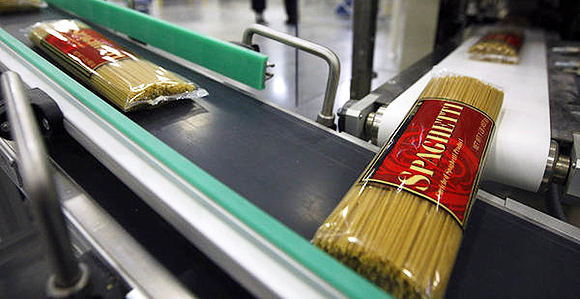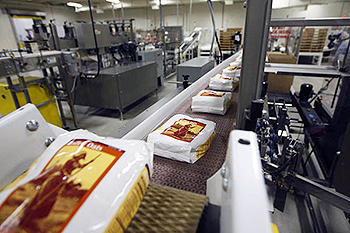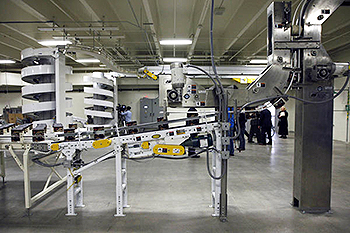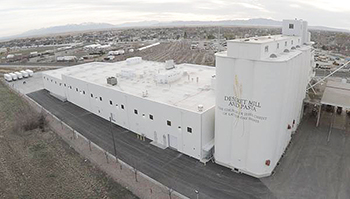LDS Church Dedicates Deseret Mill and Pasta Plant in Kaysville
Contributed By Jason Swensen, Church News staff writer

The Deseret Mill and Pasta Plant was dedicated in Kaysville Thursday, February 26, 2015.
KAYSVILLE, UTAH
The Deseret Mill and Pasta Plant could aptly be called a structural metaphor of God’s love for His children. The work performed at the massive facility will, in Christlike fashion, feed and lift people in need.
The wheat-based food produced here “will be given freely to those struggling to find a foothold in life,” said Bishop Gérald Caussé, First Counselor in the Church’s Presiding Bishopric.
Bishop Caussé presided at the February 26 formal opening of the pasta plant, which was built alongside the existing mill. He also offered the dedicatory prayer on the mill and pasta plant, located just off Interstate 15 in Utah’s Davis County.
The towering Church-owned facility covers 85,650 square feet. Its white grain silos hold 16 million pounds of wheat (that’s 270,000 bushels) and can process 200,000 pounds of grain in a single day. Meanwhile, the new pasta plant will contribute to the 20 million pounds of foodstuffs produced there each year.

Bishop Gérald Caussé, First Counselor in the Church’s Presiding Bishopric, dedicated the Church's new massive Deseret Mill and Pasta Plant February 26 in Kaysville, Utah. Photo by Jason Swenson.

The Deseret Mill and Pasta Plant was dedicated in Kaysville Thursday, February 26, 2015. Photo by Chelsey Allder, Deseret News.

The Deseret Mill and Pasta Plant was dedicated in Kaysville Thursday, February 26, 2015. Photo by Chelsey Allder, Deseret News.

The Deseret Mill and Pasta Plant was dedicated in Kaysville Thursday, February 26, 2015. Photo by Chelsey Allder, Deseret News.
But workers and volunteers at the Deseret Mill and Pasta Plant say the facility is not defined by its massive silos or staggering food outputs. Instead, it’s defined by the many families and individuals who will be sustained by the spaghetti, macaroni, and other nutritious items produced at the plant.
Bishop Caussé is a Frenchman who spent much of his professional career in the food industry. He declared the pasta and other products being produced at the Kaysville plant to be the finest around.
“We desire to serve the very best,” he said.
Bishop Caussé thanked the many who helped build the new pasta plant, along with the thousands of volunteers who help move the pasta out of the plant and to the plates of hungry people.
He explained that the plant could have been built to be almost entirely automated. “But we designed it to provide opportunities to give service.”
The purpose of providing food for people in need goes beyond filling stomachs. Satisfying physical hunger can be the first step in satisfying spiritual hunger, he said.
Don Johnson, director of production and distribution for LDS Welfare Services, said the food produced at the new facility is both nutritious and popular throughout the world.
“People love pasta,” he said in his remarks at the event.
The facility, he added, represents the “spirit of the welfare program” where volunteers and recipients of the food can work together, shoulder to shoulder.
Elder Gene R. Chidester, an Area Seventy, said the mill and pasta plant stands as a physical example of what James calls “pure religion” (James 1:27).
By dedicating the facility to the Lord, it becomes a vehicle “to bless the lives of people,” he added.
Sister Carole M. Stephens, first counselor in the Relief Society general presidency, said being at the mill and pasta plant brought back childhood memories of working on a stake welfare farm. She learned then that picking beans on the farm was sacred labor. She developed a lasting testimony of welfare service as she labored alongside family and friends.
“We were all in this work together,” she said.
Sister Stephens also spoke of the Relief Society’s rich history in the Church’s efforts in caring for people in need.
Elder Glen L. Rudd, an emeritus Seventy, is often called the Church’s “Mr. Welfare.” The 96-year-old has spent most of his life working in the welfare program, including a long tenure as the manager of Welfare Square. He also served 35 years on the Church’s Welfare Committee and on the General Church Missionary Committee.
The Deseret Mill and Pasta Plant “will bless the lives of thousands of people,” he said at the dedicatory event.
Service performed at the plant is service to the Lord, he added. Church welfare “is a simple program—helping one another and working together.”
The Deseret Pasta Plant was previously located in Kearns, Utah. But increased demand for macaroni and other pasta products necessitated construction of the new facility in Kaysville.
In the new pasta plant, semolina from the adjoining mill is held in four bins. The bins supply raw product for a trio of pasta processing lines that produce and package spaghetti, macaroni, ribbon pasta, spaghetti bites, and thin pasta for macaroni and cheese.
The pasta will be used to feed many in need, including victims of natural catastrophes and other disasters. The facility’s many food items are also made available for purchase for home food storage.
Twenty-four full-time employees and 30 missionaries work at the plant. Volunteers gleaned from local LDS congregations will also play key production roles and are expected to provide 26,000 service hours annually.
